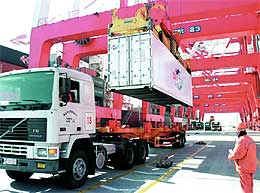Highways
The Chinese government has always taken the construction of highways as one of the important components of speeding up the construction of infrastructure facilities. In the four years from 1998 to 2001, its investment in this respect was more than 200 billion yuan each year. In 2002, the total investment in highway construction was 300 billion yuan, and 67,000 km of highways were built, including 5,700 km of expressways. By the end of 2002, the length of highways open to traffic throughout the country reached 1.7652 million km, including 25,100 km of expressways, ranking second in the world. Meanwhile, the state has speeded up the construction of highways in central and western China, and great improvements have been made in the highways there. The nation's highway density has reached 18.4 km/100 sq km.
The 12 main national arterial highways, consisting of five high-class highways from the north to the south, and seven from the east to the west, will total 35,000 km long when completed. By the end of 2002, 75 percent of these highways had been built, and 20 percent were under construction. All the national arterial highways of China are expected to be completed in 2008; Beijing and Shanghai will be linked with all the capitals of the provinces, autonomous regions and municipalities by high-class highway with expressways as the mainstay; and over 200 cities will be connected and run through by highways.
Railways
From 1990 to 2001, some 1,092 km of new railways, 837 km of multiple-tracked railways and 962 km of electrified railways were open to traffic on average annually. By the end of 2002, operating railways in China had reached 71,900 km, including 23,100 km of multiple-tracked railways and 17,900 km of electrified railways. At present, with six percent of the total operating railways in the world, Chinese railways fulfill 25 percent of the world's total railway workload, becoming one of the countries with the largest rail transport volume. China also takes the lead in the growth rate of transport volume and in the efficient use of transport equipment.
Since 1998, train speed has been raised on a large scale four times, involving a total of 13,000 km of railways. As compared with that of 1997, the average operation speed of passenger trains has increased by 25 percent. The highest speed of special express trains increased from 120 km to 160 km per hour, and the trains from Guangzhou to Shenzhen run as far as 200 km per hour at maximum.
The Qinghai-Tibet Railway with the highest elevation in the world, totaling 1,142 km, is expected to be completed in 2006. During the construction of the railway, important breakthroughs have been made in solving problems involved in permafrost, insufficient plateau oxygen and environmental protection. Now the sections constructed so far have been moved from 3,000 m to 4,700 m above sea level. The tracks from Nanshankou to the Kunlun Mountains were laid, totalling 130 km in length, in 2002; and the construction of the 420-km permafrost section from the Kunlun Mountains to the Tanggula Mountains is in full swing. The Guangdong-Hainan Railway, the first
sea-span railway in China, was formally open to traffic on January 7, 2003. It starts from Zhanjiang in Guangdong Province in the north, runs through the Leizhou Peninsula, spans the Qiongzhou Straits, meets the railway in Chahe in west Hainan Province, and ends in Sanya, totaling 345 km.
Harbors
China's coastal harbors enable the transportation of coal, containers, iron ore and grain and roll-on-roll-off ships, as well as provide deep-water access to the sea. In the construction of her harbors, China especially has strengthened the container transport system. Work in this regard has been concentrated on the construction of a group of deep-water container wharves at Dalian, Tianjin, Qingdao, Shanghai, Ningbo, Xiamen and Shenzhen, laying the basis for the shaping of China's container hubs. The construction of the coal transport system has been further strengthened. A number of coal transport wharves have been constructed. In addition, wharves for importing crude oil and iron ore have been reconstructed or expanded. By the end of 2002, the main coastal harbors had close to 1,800 berths, including some 530 10,000-ton-class berths, with a total volume of freight traffic of 1.666 billion tons. The annual volume of freight traffic of some large harbors has exceeded 100 million tons; and Shanghai, Shenzhen, Qingdao, Tianjin, Guangzhou, Xiamen, Ningbo and Dalian harbors have been included among the 50 top container harbors in the world.

Civil Aviation
At the end of 2002, China had 141 airports for regular flights. In that year, the turnover of air freight reached 5.16 billion ton-km, the passenger turnover was 126.9 billion person-km, and the volume of freight, 2.021 million tons. China had a total of 1,176 scheduled flight routes, of which 1,015 were domestic air routes, reaching 130 cities, and 161 were international air routes, reaching 62 cities in 33 countries.

